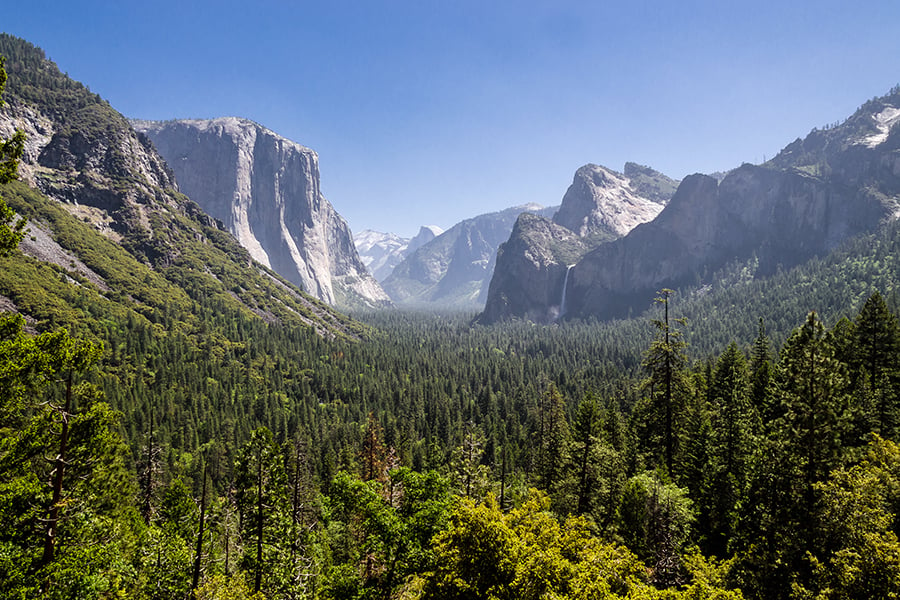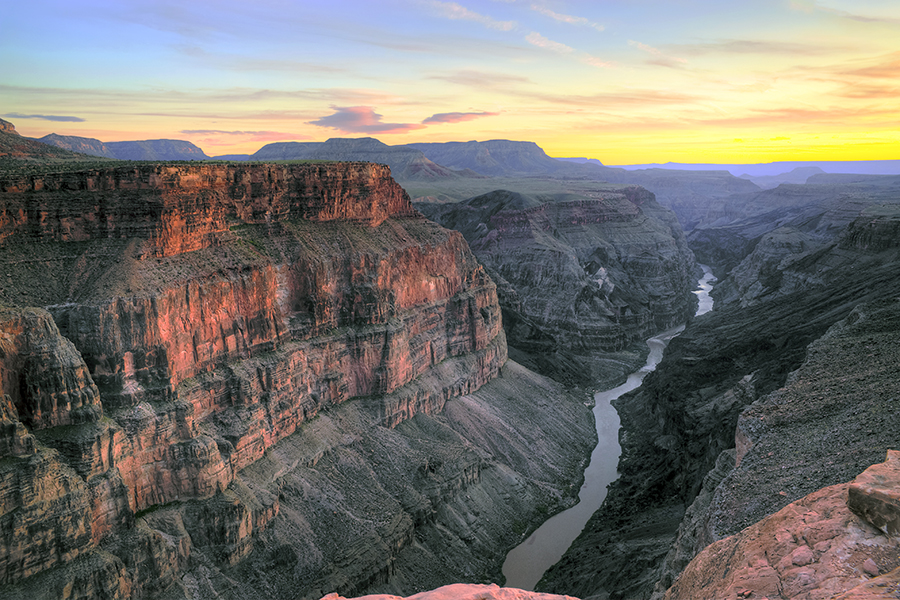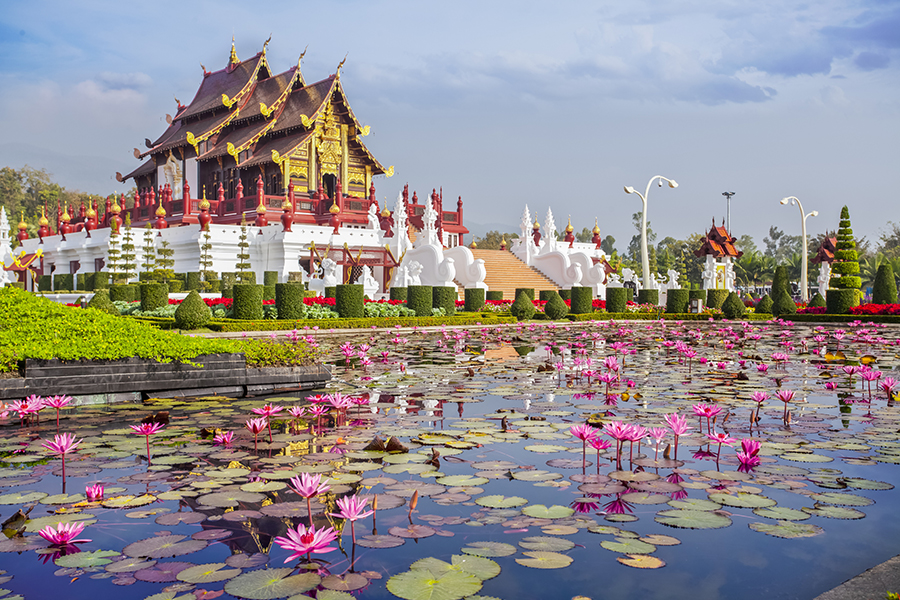We've chosen our favourites to show you how and why you should enjoy a trip to the stunning National Parks of America. Whether it's wildlife watching, relaxing on a beach, rock-climbing or just enjoying a breathtaking view, we'll help you find just what you're looking for!
If you're planning on visiting several national parks it might be worth buying a National Parks Pass, which allows you entry to all of the parks in the system. These cost $80 so if you are visiting 3 or 4 parks it is usually worth it. They can be bought online in advance or just at the first park you visit, so if you have this pass then the entry fees listed below are non-applicable. Plus it is valid for a whole year - time to plan a return trip already?
In the mainland US states, driving is almost always the most convenient to get around. If you can't do without the comforts of a hotel room, car hire is probably the best choice but if you want to get out there and experience the landscape, why not choose a camper van and discover the joys of hanging your hat wherever the road takes you.
Accommodation varies hugely in National Parks - from camping to luxury lodges, the cost can fluctuate. We can find any style of lodging you fancy; whether you'd like to keep it cheap and stay outside the park or stay right in the action at the heart of nature. Request a quote and we'll help find your perfect accommodation.
Our pick for mountains: Yosemite National Park

Yosemite National Park was one of the earliest parks to be established, way back in 1890. Deep in the heart of California it is a haven of wildlife where hiking and rock-climbing are the most popular activities. The huge El Capitan is 3000 ft at its tallest point and is a huge pull for base jumpers and climbers from around the world but if you're looking for something a bit less challenging, there are many different levels of climbing throughout the park. The hiking trails range from 0.5 to 15 miles and the stunning views of the valley are well worth the walk. Skiing is a popular activity in the winter as well as horse riding all year round but believe me, some days merely soaking up the spectacular views is activity enough!
Entry Fee: $20 per vehicle/$10 for an individual on foot - valid for a week.
Gateway City: San Francisco is the best city to fly to, as it's approx. 4 hours drive from Yosemite.
Road Trip: Yosemite is the perfect National Park to visit on a road trip - it's location in mid California means that there are scores of other great areas close by. Why not hire a car and drive the Pacific Coast Highway down to Los Angeles before looping north to Yosemite NP and visiting Lake Tahoe on your way back to San Francisco - a perfect loop of California.
Tours: If you'd rather have the logistics sorted out for you, check out our Yosemite Active Adventure tour, taking in all the highlights of the park. Hiking, camping and horseriding - you can enjoy the full Yosemite experience on this brilliant 10 day tour.
Other mountainous national parks...
Grand Teton NP in Wyoming. Just south of Yellowstone NP, Grand Teton is too often cast in it's famous neighbours shadow but head out in a canoe to the oxbow bend and the view of the Teton Mountain Range will firmly cement this beautiful park in its rightful place amongst the best.Rocky Mountains NP in Colorado. Cross the continental divide, the spine of North America, by trekking on horseback through the forests and valleys of the Rocky Mountains NP, emerging on top of the world. Experience the American Rockies at their best and you'll be itching to return!
Our pick for desert: Grand Canyon National Park

Grand Canyon National Park is definitely one of the most famous parks, especially outside of the US. The hiking trails in the canyon really are unrivalled - from an afternoon walk to a 2 week trek, there is something for everyone in this huge expanse of land. White-water rafting is also a massively popular activity, with 2 week long trips along the Colorado River offering the chance to really get under the skin of the park. Those looking for something a bit more low key - try a short trail along the South Rim where the views are plentiful and the pathways paved. If you're still craving the view, hop in a helicopter and embark on a short flight over the vast canyon - it's expensive but is often the highlight of the trip!
Entry Fee: $25 per vehicle/$12 for an individual on foot - valid for a week.
Gateway City: An added bonus to Grand Canyon NP is that the easiest city to fly into is Las Vegas, so you can combine a trip to see the canyon with a visit to glamorous 'Sin City'.
Road trip: Grand Canyon NP is part of a cluster of parks very close together in Utah and Arizona, which makes it very easy to visit lots in one trip. Starting in Vegas, you can party the night away on the strip, hopping between hotel buffets and casinos before enjoying the drive along the long winding roads of Utah to Bryce Canyon and Canyonlands National Parks. Discover the Navajo culture in Monument Valley and dip back down into Arizona to experience the wonders of the Grand Canyon. The Las Vegas Loop is the ultimate Western road trip - a must do!
Tours: For the ultimate activity filled adventure try the Hike, Bike and Raft tour which includes visits to various other national parks in the area. After the energetic loop of the desert, return to the city and have a well deserved rest by the pool of a fabulous Vegas hotel.
Other desert national parks...
Arches NP in Utah. The red rock rainbows of Arches National Park are the classic American landscape and is a photographers dream. Take your tripod and a spare memory card and you'll be snapping away from dawn to dusk!Joshua Tree NP in California. It's the perfect stop on the drive from Los Angeles to Vegas - a couple of hours hiking in the cactus strewn wilderness is a great contrast to the fast-paced glamour of these two cities.
Our pick for islands: Acadia National Park

Acadia is the only National Park in New England and its unrivalled coastal beauty attracts over 3 million visitors each year. The majority of the park is on Mount Desert Island, full of deserted beaches and endless hiking trails through the lush forest. Cycling is one of the best ways to experience the park as there are many miles of carriage roads that are perfect for mountain biking, which are available to rent. Hiking is also very popular, with trails leading right along the coast to the top of Mount Cadillac, the perfect place to watch the sun rise out of the Atlantic. Humpback whales and porpoises are often spotted off the coast but inland there are beavers and red foxes amongst the woods, as well as over 300 species of birds. Bar Harbour is an excellent place to base yourself when exploring Acadia as well as a good place to try the famous Maine lobster - fresh from the sea with lots of butter!
Entry Fee: $20 per vehicle/$5 for an individual on foot - valid for a week.
Gateway City: Boston. Explore this historic city before heading to Acadia NP up the coast. It's a six hour drive but a stop at the Cape Cod seashore is a good way to break it up.
Road trips: Including Acadia NP in a New England road trip is a great idea, especially in the autumn. Boston is the gateway to New England so after a few days in the city, pick up your car and head north to the Maine coast and Acadia. After tasting the classic Maine lobster, head west to the White Mountains of New Hampshire and take the cog railway to the top of Mount Washington. After a quick tasting session at the Ben and Jerry's factory in Stowe, Vermont skip your way back to Boston through the green and gold leaves of Massachusetts.
Other island national parks...
Dry Tortugas NP in Florida. This cluster of islands is set 70 miles west of Key West, with snorkling and diving being order of the day. With no accommodation or shops - just camping on the beach ($3 per night) - this a great park to visit when all you fancy is lying on a beach and embracing the relaxing outdoor life. Arrive by sea plane or catamaran.Channel Islands NP in California. Only a stones throw from the central California coast, the Channel Islands are a haven of marine life, from sea stars to sharks. The best way to experience the islands is by kayak - the Santa Barbara Adventure Company operate sea cave kayak tours, dipping in and out of the rugged caves and maybe even spotting a whale on the boat ride out to sea!
Our pick for wildlife: Katmai National Park

Katmai National Park is one of the most impressive places in the world to view brown bears in the wild. Lynx, red squirrels and moose are found throughout the park, as well as sea otters and killer whales off the coast, but what people really come to Katmai for is the bears. The Brooks Falls, where bears gather to catch the jumping salmon, is the best place to see them and simply gazing at these magnificent creatures can easily take up most of the day! If you are able to tear yourself away, Katmai is world renowned for its sport fishing, with rainbow trout and coho salmon abundant in the lakes and rivers of the park. Bring your gear but remember - the bears are after the fish too, so don't get too close!
Entry Fee: Free! but a camping fee of $5 applies.
Gateway City: Anchorage. Not only your gateway city but probably your base for any trip to Alaska, Anchorage is a modern city with the perks of having the wilderness of Alaska on its doorstep! A good place to return for home comforts after a few nights roughing it in more remote areas. Katmai is a short flight from Anchorage down to King Salmon near Kodiak Island.
Other wildlife filled national parks...
Yellowstone NP in Wyoming. Yellowstone is a haven for animals, especially mammals including bison, wolverines, grizzly and black bears, cougars, moose and the recently reintroduced wolves. Keep your distance when watching the wildlife - the highest concentration of wild animals in the US is not to be trifled with!Everglades NP in Florida. The subtropical mangroves of the Everglades are teeming with wildlife and the best way to encounter the marshes is by canoe/kayak. The park provides free trail maps so renting a canoe and paddling around the swamps is pretty easy and worth it when you start spotting that wildlife! Alligators, crocs, flamingoes, cormorants, river otters - the list goes on for miles and with a bit of luck they can all be spotted from a kayak.
Our pick for trees: Great Smoky Mountains National Park

The Great Smoky Mountains National Park is the most visited park in the USA. The vast landscapes of America would be nothing without the trees and this park is an excellent example of their beauty. Head to the park in autumn for the stunning red and gold colours and you'll be able to experience the park in its full majesty - hike to the double peaked summit of Chimney Tops for a stunning 360 degree panorama of the surrounding forests. Horse riding and fly fishing are also available and are a great way to immerse yourself into the relaxed pace of life of the park. If you are a really keen walker, why not tackle the Appalachian Trail, from Georgia to Maine. At a mere 2,200 miles its certainly a long one but if you're up for the challenge the months long hike is a real achievement to have completed. The trail passes right through the Great Smoky Mountains NP and is a fantastic way to experience rural America.
Entry Fees: Free!
Gateway City: Knoxville, Tennessee. A small college city, Knoxville is a fantastic southern charm and is situated perfectly for a day trip to Nashville, or as it's commonly known 'Music City'.
Road trip: If you're interested in exploring other parts of the Deep South, why not fly into Washington DC and drive the beautiful Blue Ridge Parkway through Virginia and North Carolina before heading into Great Smoky Mountains NP and finishing the trip in the bright lights of Atlanta or Knoxville.
Other tree filled national parks:
Redwood NP in California. This beautiful park was created to protect the groves of redwood trees that are native to California and Oregon. The best time to visit is dawn when fog clings to the trees in the early morning haze and you can experience the ethereal splendour the trees are famous for.Kings Canyon and Sequoia NP in California. Though not the tallest, General Sherman, located in Sequoia NP has the largest volume of any living tree on earth. Standing at the bottom and looking up, it's hard to find a more humbling spot to marvel at the joys of nature.
Our pick for geothermal activity: Hawaii Volcanoes National Park

A visit to Hawaii usually inspires images of white sand and clear blue waters but Hawaii is so much more than just its beautiful beaches. The Hawaii Volcanoes National Park is located on the Big Island of Hawaii and Kilauea is the most active of the 5 volcanoes. Kilauea has been erupting into the sea continually since 1983 and new land of Hawaii is being created every day. The lava is especially enchanting after dark when you can easily spot the orange red glow as it streams into the sea with a puff of steam. For a fantastic view of the smoking caldera, head to the Jaggar Museum which also houses working seismographs. A visit to the volcanoes is an essential part of any trip to Hawaii and the stunning geothermal activity of the islands really is a wonder to behold.
Entry Fees: $10 per vehicle/$5 for an individual on foot, bike or moped - valid for a week.
Gateway City: Honolulu. Most international flights will arrive in Honolulu which is on the island of Oahu, however you can easily hop onto another aircraft and make your way to any of the major islands, including the Big Island, where the Hawaii Volcanoes NP is.
Road Trip: A great way to get around Hawaii, whichever island you are on, is by scooter. You don't need to have a license to drive a scooter less than 49cc so you can hop on a moped and zoom around the islands exploring. It's a great way to make sure you don't just sit on the beach and really experience the varied and exciting culture of Hawaii.


























